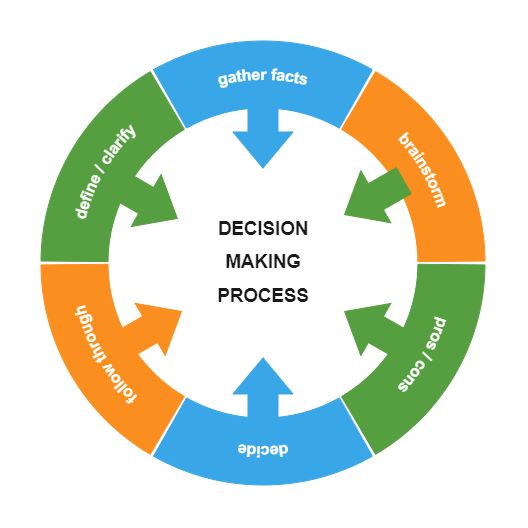DECISION MAKING PROCESS
DECISION MAKING PROCESS
two main types of decisions are:
Programmed Decisions:
- Programmed decisions are routine and repetitive decisions that follow established procedures or rules. These decisions are well-structured and have clear criteria for decision-making.
- They are often made in predictable situations where the outcomes and alternatives are known in advance.
- Examples of programmed decisions include inventory management, scheduling routine tasks, and applying standardized procedures.
Non-Programmed Decisions:
- Non-programmed decisions are unique, complex, and unstructured decisions that arise in unfamiliar or unpredictable situations.
- These decisions require creativity, judgment, and problem-solving skills because there are no predetermined rules or procedures to follow.
- Non-programmed decisions are often made by managers at higher levels of the organization and involve strategic planning, crisis management, and handling novel situations.
Steps involved in the decision-making process:
Identify the Problem:
- The first step in decision making is to identify and define the problem or opportunity that requires a decision.
- This involves recognizing the gap between the current state and the desired state, determining the root causes of the problem, and clarifying the objectives to be achieved.
Gather Information:
- Once the problem is identified, gather relevant information to understand the situation fully.
- This may involve collecting data, conducting research, consulting experts, and seeking input from stakeholders.
- The quality and accuracy of the information gathered significantly influence the effectiveness of the decision.
Generate Alternatives:
- Brainstorm and generate a range of possible solutions or alternatives to address the problem or capitalize on the opportunity.
- Encourage creativity and consider multiple perspectives to explore diverse options.
- Evaluate the pros and cons of each alternative, considering factors such as feasibility, risks, costs, and benefits.
Evaluate Alternatives:
- Assess the potential outcomes of each alternative against the established criteria and objectives.
- Use decision-making tools and techniques, such as decision matrices, cost-benefit analysis, or SWOT analysis, to compare and prioritize alternatives.
- Consider the short-term and long-term implications of each alternative and anticipate potential consequences.
Make the Decision:
- Select the best alternative based on the evaluation and analysis conducted.
- Make the decision promptly, considering the urgency of the situation and the available resources.
- Ensure that the decision aligns with organizational goals, values, and ethical standards.
Implement the Decision:
- Once the decision is made, put the chosen alternative into action by developing an implementation plan.
- Assign responsibilities, allocate resources, and establish a timeline for implementation.
- Communicate the decision to relevant stakeholders and provide support and guidance to facilitate successful execution.
Monitor and Evaluate:
- Continuously monitor the implementation of the decision to ensure that it is proceeding according to plan.
- Evaluate the effectiveness of the decision by measuring outcomes against the desired objectives.
- Adjust the implementation strategy as needed and learn from the results to improve future decision-making processes.
By following these steps, organizations can make informed and effective decisions, whether they are addressing routine, programmed decisions or tackling complex, non-programmed situations.
Decision-making is one of the leadership functions which is used by the leaders on the daily basis.
TASK- Explain the two main types of decisions. Mention steps that are involved in decision making process. (10 Marks)
MARKING KEY - DECISION MAKING
TYES OF DECISIONS
1. Programmed: implement solutions that have already been determined by past experience as appropriate for the problem at hand.(2 Marks)
2. Non-programmed: decisions for problems that have not been encountered before.(2 Marks)
STEPS IN DECISION MAKING PROCESS
Identify participants
Gather pertinent facts
Generate alternative decisions
Predict outcomes
Plan for managing consequences
Select the best alternative.
(Give a mark for each point mentioned) = 6 Marks







.jpg)
Comments
Post a Comment